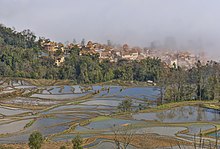Hani rice terraces
The Honghe Hani Rice Terrace has been added to the UNESCO World Heritage List .
On June 22, 2013, the UNESCO World Heritage Committee decided at the 37th World Heritage Conference in the Cambodian capital Phnom Penh to recognize the Honghe Hani rice terraces in the southern Chinese province of Yunnan as a World Heritage Site. Wording: "The Hani people have formed an extraordinarily complex system of irrigated rice terraces out of the dense forest".
In Yunnan, the rice terraces have been on the World Heritage List as protection zones in the National Park of the “ Three Parallel Rivers ” since 2003 .
location
The Honghe Hani Rice Terraces in southern China's Yunnan Province have a history of more than 1,300 years. The residents still grow rice on the terraces to this day.
The rice terraces are spread all over the southern bank of the Hong He , for example in the districts of Yuanyang , Lüchun and Jinping of the Honghe Autonomous District of the Hani and Yi . Especially the rice terraces in Yuanyang with an area of 12.6 thousand ha (approx. 126 square kilometers, Berlin: 883 square kilometers) are the most famous part. Because Yuanyang has a rich spring, moist air and changeable fog, a lively landscape is formed here.
Rice terrace culture
2000 years ago, the ancestors of the Hani moved to Honghe in Yunnan and built the first rice terrace on a mountain slope there. Then water channels were built step by step. Through the canal system, people use the natural rainwater of the high mountains for irrigation.
They also breed fish in the rice terraces. The rice terraces provide the fish with enough water and food, for example water plants or insects. At the same time, the water rice receives natural fertilizer from the fish.
Generations of the Hani nationality work on the rice terraces and always strive for a balance between nature and people.
Yuanyang rice terraces
The rice terraces in Yunnan Province are spread over the southern bank of the Honghe River (Yuanyang County, Jinping, Lüchun and Honghe). Here the Yuanyang rice terraces are more concentric.
The Yuanyang Rice Terraces are located in Yuanyang County, where steep mountain ranges and high mountains can be seen everywhere. The rice terraces are laid out with retaining walls on the approx. 2000 meter high mountain slopes at a gradient of 15 - 75 degrees. The gradation of the rice terraces can be over 3700.
The Yuanyang rice terraces consist of three main landscape zones (Duoyishu rice terraces, Laohuzui rice terraces, Bada rice terraces) and a few small-sized rice terraces.
Duoyishu rice terraces
The Duoyishu Rice Terrace is 55 kilometers from Yuanyang. This landscape zone consists of five villages of the Hani nationality and four villages of the Yi nationality with an area of 400 hectares, including the rice terraces, or 16,000 hectares of jungle.
Laohuzui rice terraces
The Laohuzui rice terraces are called tiger-mouth rice terraces because they look like a tiger's mouth. They are located 50 kilometers south of Yuangyang. Because of the steep relief and the massive landscape, the Laohuzui rice terraces are known as the "plastic of the earth".
At sunset the sun shines on the rice terraces, because of the refraction of the rays, the rice terraces show different colors.
Bada rice terraces
The Bada rice terraces have an area of 950 hectares.
Web links
Individual evidence
- ↑ UNESCO World Heritage Center: Cultural Landscape of Honghe Hani Rice Terraces. Retrieved August 19, 2017 .
- ↑ UNESCO World Heritage Center: Cultural Landscape of Honghe Hani Rice Terraces. Retrieved August 19, 2017 .
Coordinates: 23 ° 5 ′ 36 ″ N , 102 ° 46 ′ 48 ″ E


